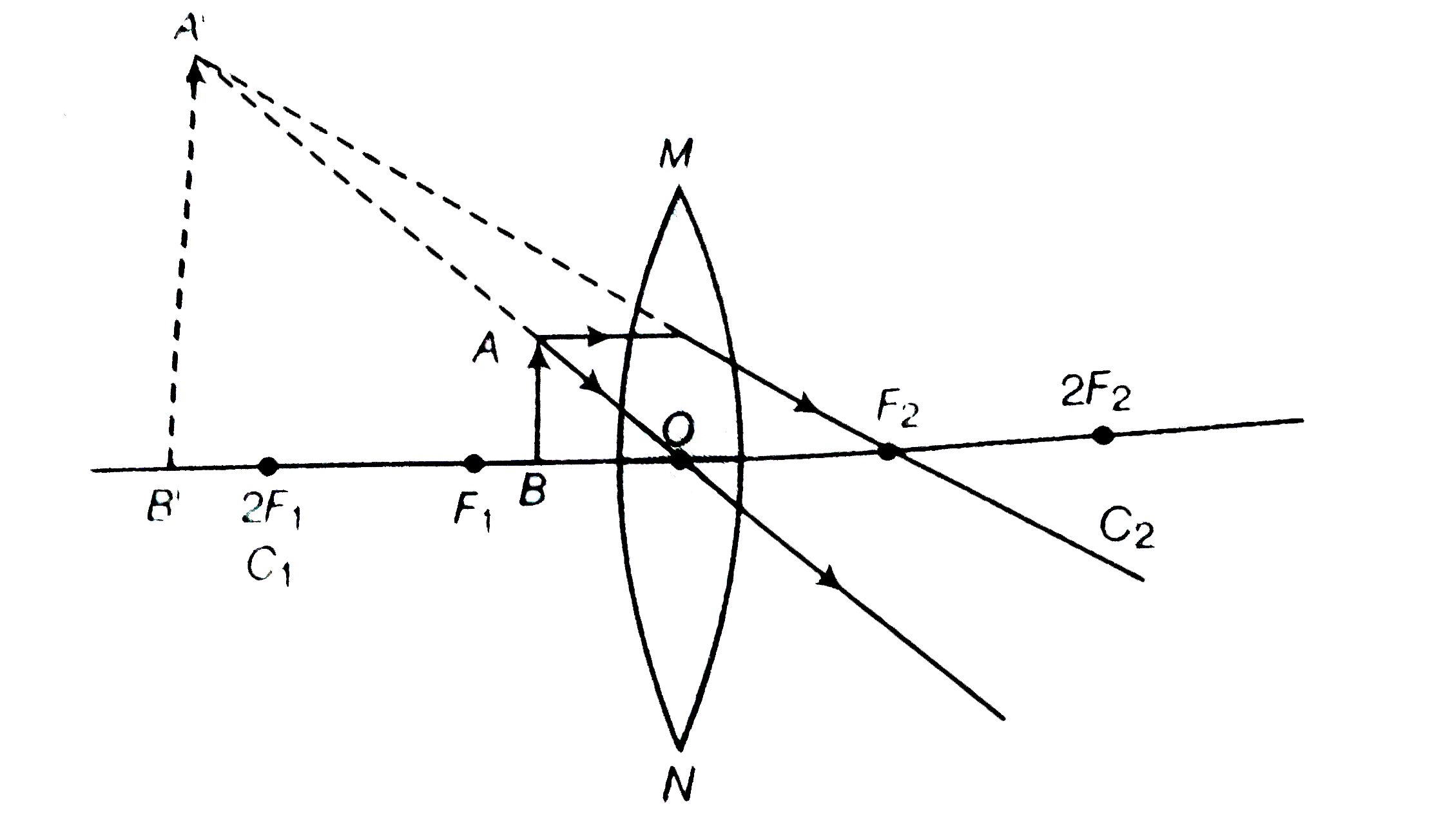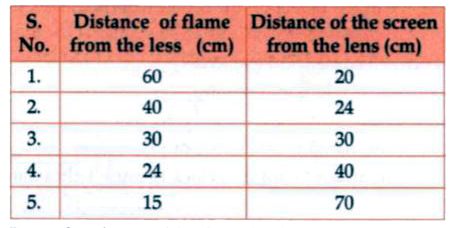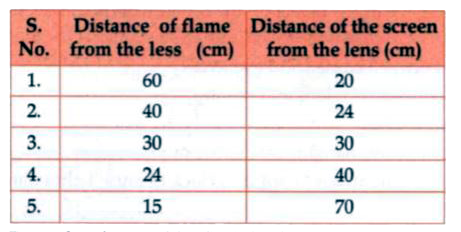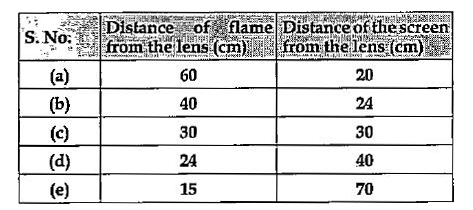A student focussed the image of a candle flame on a white screen using a convex lens. He noted down the position of the candle, screen and the lens as under
Position of candle =12.0cm
Position of convex lens =50.0cm
Position of the screen =88.0cm
(i) What is the focal length of the convex lens ?
(ii) Where will the image be formed if he shifts the candle towards the lens at a position of 31.0cm.
(iii) What will be the nature of the image formed if he further shifts the candle towards the lens ?
(iv) Draw a ray diagram to show the formation of the image in case (iii) as said above.
Object distance u = Position of the convex lens - Position of candle
=50 - 12 = 38 cm
By sign convention, u = -38cm
Similarly, Image distance, v = position of the screen - position of convex lens
=88 - 50 = 38 cm
By sign convention, v = + 38 cm
(i) Using lens formula,
1v−1u=1f
1f=138−1−38=238=119
f=19cm
The focal length of the convex lens is 19 cm.
(ii) After shifting the candle towards the lens at a position of 31.0 cm, then
object distance u = position of convex lens - position of candle
= 50 - 31 = 19
By sign convention, u = -19 cm , but here focal length of the convex lens is also 19 cm.
So, the candle lies at the focus of lens, hence its image forms at infinity.
(iii) When student further shifts the candle towards the lens i.e., candle lies between optical centre and focus of convex lens, then lens forms enlarged, virtual and erect image of the candle.
(iv) The ray diagram showing the formation of image

Topper's Solved these Questions
Similar Questions
A student focussed the image of a candle flame on a white screen using a convex lens. He noted down the positive of the candle, screen and the lens as under.
Position of candle = 12.0 cm
Position of the screen = 50.0 cm
Position of the screen = 88.0 cm
(i) What is the focal length of the convex lens ?
(ii) Where will the image be formed if he shifts the candle towards the lens at a position of 31.0 cm ?
(iii) What will be the nature of the image formed if the further shifts the candle towards the lens ?
(iv) Draw a ray diagram to show the formation of the image in case (iii) as said above .
View SolutionRohit focused the image of a candle flame on a white screen using a convex lens. He noted down the position of the candle, screen and lens as under:
Position of candle = 26.0 cm
Position of convex lens = 50.0 cm
Position of screen=74.0 cm
(i) What is the focal length of the convex lens ?
(ii) Where will the image be formed if he shifts the candle towards the lens at a position of 38 cm ?
(iii) Draw a ray diagram to show the formation of the image in case (ii) as said above?
View Solution
Knowledge Check
A student focussed the image of a candle flame on a white screen by placing the flame at various distances from a convex lens. He noted his observations as :

What type of lens is a convex lens?ADiverging lensBConverging lensCFlat lensDNon-converging lensA student obtains a blurred image of a distant object on a screen using a convex lens. To obtain a distinct image on the screen he should move the lens
Aaway from the screenBtowards the screenCto a position very far away from the screenDeither towards or away from the screen depending upon the position of the object.A student focussed the image of a candle flame on a white screen by placing the flame at various distances from a convex lens. He noted his observations as:

Which set of observations is incorrect?Aa)Bc)Ce)Dd)
Rohit focussed the image of a candle flame on a white screen using a convex lens. He noted position of candle =26.0cm, position of convex lens =50.0cm and position of screen =74.0cm.
(i) What is focal length of convex lens?
(ii) Where will the image be formed if he shifts the candle towards the lens at a position of 38 cm ?
(iii) Draw a ray diagram to show the formation of image in (ii) above.
View SolutionA student obtains a blurred image of a distant object on a screen using a convex lens. To obtain a distinct image on the screen he should move the lens
View SolutionA student obtains a blurred image of a distant object on a screen using a convex lens. To obtain a distinct image on the screen he should move the lens
View SolutionA student focussed the image of a candle flame on a white screen by placing the flame at various distances from a convex lens. He noted his observations as :

Which set of observations is incorrect?
View SolutionA student focussed the image of a candle flame on a white screen by placing the flame at various distances from a convex lens. He noted his observations as:

Which of the following statement is false for the formation of images by convex lens?
View Solution

